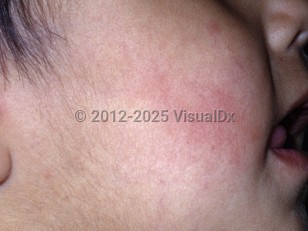Auriculotemporal syndrome in Adult
Alerts and Notices
Important News & Links
Synopsis

Auriculotemporal syndrome (also known as Frey syndrome or gustatory sweating syndrome) is a rare neurologic disorder of autonomic dysreflexia producing hyperhidrosis and facial flushing. This condition is thought to be the result of an injury to the parasympathetic nerves of the face or neck near the parotid glands, causing the nerves to aberrantly regenerate and innervate superficial blood vessels and sweat glands rather than the salivary glands.
Auriculotemporal syndrome often occurs after facial surgery or trauma. Up to 60% of patients can develop this syndrome after parotid gland surgery. Onset of symptoms can occur in the immediate postoperative period or may be delayed for several months after surgery.
The main sign is gustatory sweating, which is excessive sweating in the facial and periauricular areas after eating (especially foods that produce a strong salivary response such as sour, spicy, or salty foods). Flushing and erythema may also occur. Cases range from mild to severe.
Anticholinergics or antihidrotics are the first course of treatment.
Related topic: Hyperhidrosis
Auriculotemporal syndrome often occurs after facial surgery or trauma. Up to 60% of patients can develop this syndrome after parotid gland surgery. Onset of symptoms can occur in the immediate postoperative period or may be delayed for several months after surgery.
The main sign is gustatory sweating, which is excessive sweating in the facial and periauricular areas after eating (especially foods that produce a strong salivary response such as sour, spicy, or salty foods). Flushing and erythema may also occur. Cases range from mild to severe.
Anticholinergics or antihidrotics are the first course of treatment.
Related topic: Hyperhidrosis
Codes
ICD10CM:
G50.8 – Other disorders of trigeminal nerve
SNOMEDCT:
45294007 – Auriculotemporal Syndrome
G50.8 – Other disorders of trigeminal nerve
SNOMEDCT:
45294007 – Auriculotemporal Syndrome
Look For
Subscription Required
Diagnostic Pearls
Subscription Required
Differential Diagnosis & Pitfalls

To perform a comparison, select diagnoses from the classic differential
Subscription Required
Best Tests
Subscription Required
Management Pearls
Subscription Required
Therapy
Subscription Required
References
Subscription Required
Last Reviewed:04/03/2019
Last Updated:04/03/2019
Last Updated:04/03/2019
Auriculotemporal syndrome in Adult

